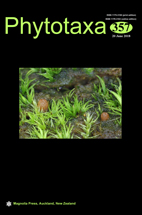Abstract
A new variety of the marine diatom Haslea crucigeroides, H. crucigeroides var. australis, var. nov., is described here based on phytoplankton samples collected in sub-Antarctic coastal waters of the southern South America and Antarctica. The new taxon was characterized by using light and electron microscopy, and the holotype of H. crucigeroides, the only existing material type, was analyzed with light microscopy. Haslea crucigeroides var. australis differs from the nominal variety by having acute valve apices instead of acute rostrate; furthermore, it has a different geographical distribution. The species is being recorded in the Southern Hemisphere for the first time. Cell abundance and a brief discussion on the species habitat are also presented.

